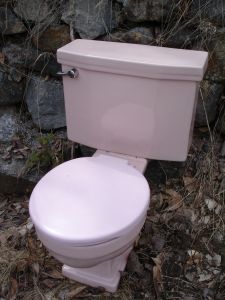Low Flow Toilets for a More Powerful Flush
Download Audio VersionLow flow toilets are ecologically friendly in that they use less water than conventional ones. In some countries, the local authorities offer rebates for buying a low flow fixture.
Conventional Toilets and Water Use
Toilets use a lot of water per flush. Fixtures that were made in the 80s use about 27 liters while those manufactured in the 90s and later use 6 liters per flush. To check the volume of the fixture, you can contact a water auditor who will measure the water used per flush. There are DIY methods as well. Models with standard flushing mechanisms use more water than those with black cylinders. You can also measure the volume by shutting off the supply valve that is found at the back of the toilet. Remove the lid, check the level, and mark it. Flush the toilet to empty the water tank. Take a 1-liter bowl or bottle and start refilling until you reach the mark. Count how many bowls you poured to reach the mark. This way, you will determine the amount of water used per flush. If the volume is between 13 and 27 liters, it is time to replace the fixture with a new or low flow toilet.
Comparison Shopping
There are different factors to consider, including model, design, noise, waste removal, and others. Many manufacturers advertise efficient toilets that use less than 5 liters per flush. Independent laboratories check the volume and whether the fixture removes waste effectively. The design of the toilet is particularly important because it determines whether waste is cleared well. Elongated bowls are not as good as round bowls and consume less water.

In terms of savings, a low flow toilet will cut your utility bill by up to $90 per year. How much you save, however, depends on the flush mechanism and the design. Most toilets are fitted with a gravity-flush mechanism whereby flowing water is used to clear waste. There are also tank-inside-tank or pressure assisted models that are often found in hotels, restaurants, public buildings, and commercial settings. The mechanism compresses air and uses less water. In fact, some models use just 3 liters of water per flush. The downside is that they don’t work properly in homes with poor water pressure.
Features of Low Flow Toilets
Low flow fixtures come with different water-saving features such as glazed and large trapways and large flapper valves that allow for a good flush force. Toilets with large trapways offer some advantages, and one is the reduced incidence of clogs. Pressure-assisted flushing mechanisms also improve the flush force. The problem is that such toilets are noisier than conventional ones.
Models and Water-friendly Technologies
Generally, there are three models to choose from – power-assist, two-button flush and gravity-fed tanks. The latter are the least expensive option. Two-button flush toilets have two options – full-flush and half-flush for liquids and solids, respectively. This is also known as dual flush toilet that features a more powerful and less powerful flush. Such toilets are especially popular in countries with dry climates such as Australia. The idea of using water-friendly technologies was actually born in Australia. Today, they are used in many countries in Asia and Europe.
Concern for the Environment
Is there a way to determine whether you have a low flow or standard toilet? If the model was produced before 1992, the chances are that you have a conventional toilet. In this case, 35 percent of water is used by the shower, 30 percent by the toilet, and 20 percent by the washing machine. A family with two children saves 53,000 liters a year by installing a low flow toilet. According to experts, if low flow models replace conventional ones, this would result in considerable savings – more than 7.5 million liters of water a day in the U.S. alone. Water conservation is increasingly important because of problems such as climate change, old drainage systems, and growing population.
Benefits of Installing a Low Flow Toilet
Water conservation is an obvious advantage given the fact that many countries face water shortages. Inefficient management of resources and increased water use are just two of the reasons for water shortages. The rising cost of water and other utilities explains why more and more people opt for cost-effective solutions. It is also popular with people who are looking for ways to preserve the planet’s fresh water sources. Stricter government regulation on water use and increased awareness of the depletion of non-renewable resources make water and energy conservation more important. Moreover, in addition to rebates, many governments also offer tax incentives to homeowners who change their toilet with a high-efficiency model. Rebates are offered to consumers who buy a toilet that performs well and is eco-friendly. In some countries, the authorities have published a list of models and manufacturers that qualify for rebates.
Another advantage is that new low flow toilets have a modern design and look. They go well with different fixtures, interiors, and décor styles. Customers can choose from different models, including one- and two-piece toilets.
Downsides to Consider
Some models need more frequent cleaning and are not effective in forcing waste. This is a serious problem that can lead to burst pipes, blockages, and backups. Fortunately, new models are quite efficient, and this problem has been almost fully resolved.
Related Articles
Water-efficient Showerheads and Faucets to Reduce Waste
Water-efficient products are good for the environment and save a lot of money. Installing kitchen taps, shower handsets and controls, basin taps and baths that conserve water will help reduce soil and water contamination. Sink FaucetsSome manufacturers offer sink faucets that help reduce the water...
Eco Friendly Plans for High-Tech and Compact Homes
Eco friendly home plans focus on energy and water conservation. They aim to reduce the negative effect of building and use of resources on the environment and human health. Features of Green Home Plans Architects design homes that use recyclable materials, energy-efficient lighting,...


